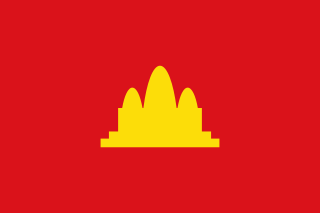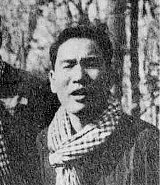Related Research Articles

The Khmer Rouge is the name that was popularly given to members of the Communist Party of Kampuchea (CPK) and by extension to the regime through which the CPK ruled Cambodia between 1975 and 1979. The name was coined in the 1960s by then Chief of State Norodom Sihanouk to describe his country's heterogeneous, communist-led dissidents, with whom he allied after his 1970 overthrow.

Ta Mok, also known as Nguon Kang, was a Cambodian military chief and soldier who was a senior figure in the Khmer Rouge and the leader of the national army of Democratic Kampuchea. He was also known as "Brother Number Four" or "the Butcher". He was captured along the Thailand-Cambodia border in March 1999 by Cambodian government forces while on the run with a small band of followers and was held in government custody until his death in 2006 while awaiting his war crime trial.

The Party of Democratic Kampuchea was a political party in Cambodia, formed as a continuation of the Communist Party of Kampuchea in December 1981. In the mid-1980s, it publicly claimed that its ideology was "a new form of democratic socialism", having ostensibly renounced Marxism–Leninism.

The Kingdom of Cambodia, also known as the First Kingdom of Cambodia, and commonly referred to as the Sangkum period, refers to Norodom Sihanouk's first administration of Cambodia from 1953 to 1970, an especially significant time in the country's history. Sihanouk continues to be one of the most controversial figures in Southeast Asia's turbulent and often tragic postwar history. From 1955 until 1970, Sihanouk's Sangkum was the sole legal party in Cambodia.

Son Sen, alias Comrade Khieu (សមមិត្តខៀវ) or "Brother Number 89", was a Cambodian Communist politician and soldier. A member of the Central Committee of the Communist Party of Kampuchea/Party of Democratic Kampuchea, the Khmer Rouge, from 1974 to 1992, Sen oversaw the Party's security apparatus, including the Santebal secret police and the notorious security prison S-21 at Tuol Sleng.

Khieu Samphan is a Cambodian former communist politician and economist who was the chairman of the state presidium of Democratic Kampuchea (Cambodia) from 1976 until 1979. As such, he served as Cambodia's head of state and was one of the most powerful officials in the Khmer Rouge movement, although Pol Pot remained the General Secretary in the party.

The Cambodian–Vietnamese War was an armed conflict between Democratic Kampuchea, controlled by Pol Pot's Khmer Rouge, and the Socialist Republic of Vietnam. The war began with repeated attacks by the Liberation Army of Kampuchea on the southwestern border of Vietnam, particularly the Ba Chúc massacre which resulted in the deaths of over 3,000 Vietnamese civilians. On 23 December 1978, the Khmer Rouge's military divisions opened fire along the shared Southwestern borderline with Vietnam with the goal of invading the Vietnamese provinces of Đồng Tháp, An Giang and Kiên Giang. On 25 December 1978, Vietnam launched a full-scale invasion of Kampuchea, and subsequently occupied the country and removed the government of the Communist Party of Kampuchea from power.

Nuon Chea, also known as Long Bunruot or Rungloet Laodi, was a Cambodian communist politician and revolutionary who was the chief ideologist of the Khmer Rouge. He also briefly served as acting Prime Minister of Democratic Kampuchea. He was commonly known as "Brother Number Two", as he was second-in-command to Khmer Rouge leader Pol Pot, General Secretary of the Party, during the Cambodian genocide of 1975–1979. In 2014, Nuon Chea received a life sentence for crimes against humanity, alongside another top-tier Khmer Rouge leader, Khieu Samphan, and a further trial convicted him of genocide in 2018. These life sentences were merged into a single life sentence by the Trial Chamber on 16 November 2018. He died while serving his sentence in 2019.

The Coalition Government of Democratic Kampuchea, renamed in 1990 to the National Government of Cambodia, was a coalition government in exile composed of three Cambodian political factions, namely Prince Norodom Sihanouk's FUNCINPEC party, the Party of Democratic Kampuchea and the Khmer People's National Liberation Front (KPNLF) formed in 1982, broadening the de facto deposed Democratic Kampuchea regime. For most of its existence, it was the internationally recognized government of Cambodia.

Kampuchea, officially Democratic Kampuchea (DK) from 1976 onward, was the Cambodian state from 1975 to 1979, under the totalitarian dictatorship of Pol Pot and the Communist Party of Kampuchea (CPK), commonly known as the Khmer Rouge (KR). It was established following the Khmer Rouge's capture of the capital Phnom Penh, effectively ending the United States-backed Khmer Republic of Lon Nol.

Hu Nim, alias "Phoas" (ភាស់), was a Cambodian Communist intellectual and politician who held a number of ministerial posts. His long political career included spells with the Sangkum regime of Prince Norodom Sihanouk, the Communist guerrilla resistance, the GRUNK coalition government-in-exile, and the administration of Democratic Kampuchea, when the country was controlled by the Communist Party of Kampuchea.
The Sangkum Reastr Niyum, usually translated as Popular (or People's) Socialist Community and commonly known simply as the Sangkum, was a political organisation set up on 22 March 1955 by Prince Norodom Sihanouk of Cambodia. Though it described itself as a 'movement' rather than a political party, the Sangkum retained control of the government of Cambodia throughout the first administration of Sihanouk, from 1955 to 1970. Central to the Sangkum ideology were nationalism, conservatism, preserving the monarchy, and a conservative interpretation of Buddhism.
The National United Front of Kampuchea was an organisation formed by the deposed then Chief of State of Cambodia, Norodom Sihanouk, in 1970 while he was in exile in Beijing.

The Royal Government of the National Union of Kampuchea was a government-in-exile of Cambodia, based in Beijing and Hong Kong, that was in existence between 1970 and 1976, and was briefly in control of the country starting from 1975.
The Patriotic and Democratic Front of the Great National Union of Kampuchea (PDFGNUK) was a Kampuchean mass organization set up by the Communist Party of Kampuchea on August 21, 1979 after the fall of Democratic Kampuchea to Vietnamese troops and the subsequent proclamation of the People's Republic of Kampuchea. It was set up as a counterpart to the Kampuchean United Front for National Salvation that had been nurtured by the Vietnamese. Its purpose was to rally anti-Vietnamese nationalists to support the Khmer Rouge, as part of an effort to legitimize the discredited Democratic Kampuchea regime. It was announced by Khieu Samphan, who was elected its provisional chairman. The PDFGNUK can be seen as an attempt to revive the goals of the similar GRUNK coalition of the early 1970s, an organization that united the Khmer Rouge and pro-Sihanouk forces opposing the Khmer Republic.
The Cambodian National Unity Party was a political party set up by the Khmer Rouge on 30 November 1992, during the United Nations Transitional Authority in Cambodia to participate in the elections that year. The party was led by Khieu Samphan and Son Sen. It succeeded the Party of Democratic Kampuchea after 1993. As with the PDK, the National Army of Democratic Kampuchea was said to be its armed wing. Its professed aim at its founding was to "work towards implementing multi-party liberal democracy." Its radio station was known as the Voice of the Great National Union Front of Cambodia until being replaced in July 1994 by PGNUNSC Radio.

The Provisional Government of National Union and National Salvation of Cambodia (PGNUNSC) was an internationally unrecognised and ostensibly provisional government set up by the Khmer Rouge on July 11, 1994, in opposition to the established Kingdom of Cambodia.

The Communist Party of Kampuchea (CPK), also known as the Khmer Communist Party, was a communist party in Cambodia. Its leader was Pol Pot, and its members were generally known as the Khmer Rouge. Originally founded in 1951, the party was split into pro-Chinese and pro-Soviet factions as a result of the Sino–Soviet split with the former being the Pol Pot faction, and the latter adopting a more revisionist approach to Marxism. As such, it claimed that 30 September 1960 was its founding date; it was named the Workers' Party of Kampuchea before it was renamed the Communist Party in 1966.

The Cambodian genocide was the systematic persecution and killing of Cambodian citizens by the Khmer Rouge under the leadership of Communist Party of Kampuchea general secretary Pol Pot. It resulted in the deaths of 1.5 to 2 million people from 1975 to 1979, nearly a quarter of Cambodia's population in 1975.

The Cambodian Conflict or Khmer Rouge Insurgency., was an armed conflict that initiated in the Cambodian-Vietnamese War, Vietnam which provoked the deposition of Democratic Kampuchea, between the new Cambodian government and an anti-government coalition led by the Khmer Rouge.
References
- ↑ Alan John Day, Richard German, and John Campbell (ed.). Political Parties of the World. 1996. New York: Stockton. p. 109.
- ↑ Bogdan Szajkowski (Ed.). Revolutionary and Dissident Movements of the World. John Harper Publishing. 2004. p. 54.
- 1 2 Asian Network for Free Elections. Cambodia: Struggling for Justice and Peace: Report of Missions on the 1998 Cambodian Election. 1999. p. 106.
- ↑ Far East and Australasia 2003. 2002. p. 236.
- ↑ The Europa World Year Book 2004 Volume I. London: Taylor & Francis. 2004. p. 966.
